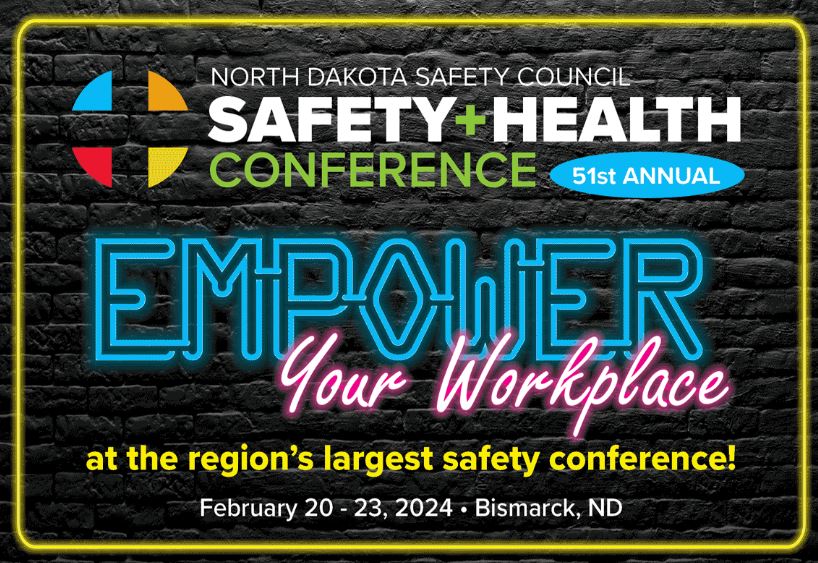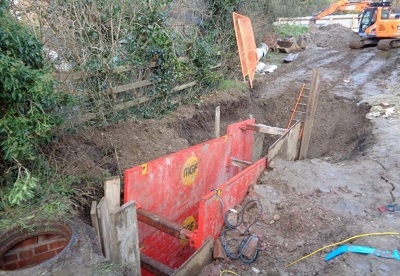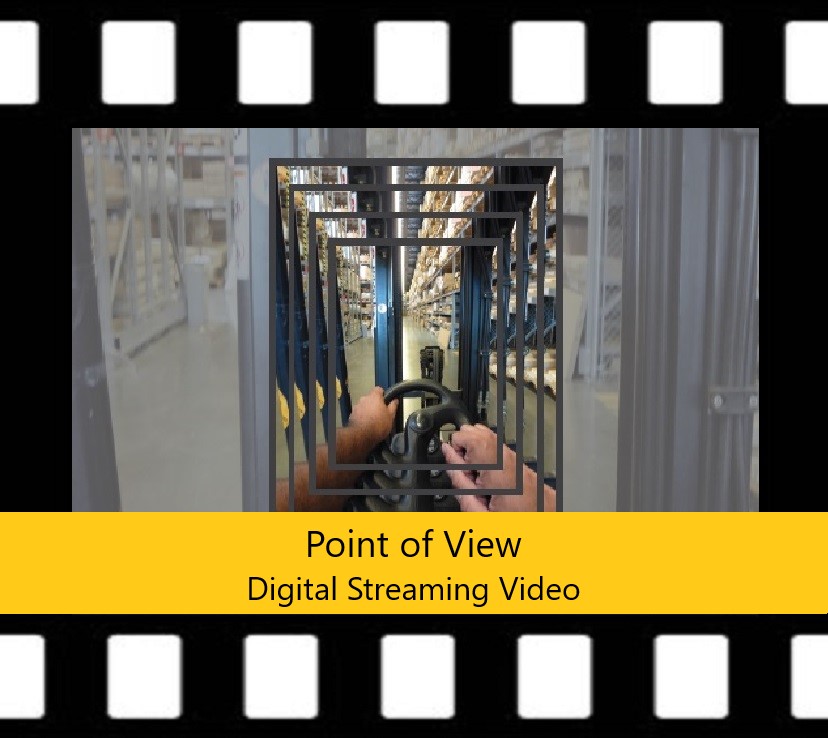But first, check out all the places we are delivering training this month...

Feature Article: NEW Product! First of New Video Series, Did You Catch That? Now Available.
 The release of the new video, Did You Catch That? Standard Forklift Vol.1, is the first title issued in what will become a series of DYCT videos in which viewers are challenged to spot as many errors as they can while watching an operator perform various tasks with a piece of powered mobile equipment.
The release of the new video, Did You Catch That? Standard Forklift Vol.1, is the first title issued in what will become a series of DYCT videos in which viewers are challenged to spot as many errors as they can while watching an operator perform various tasks with a piece of powered mobile equipment.
Now, you may ask, why would IVES make a video showing people making mistakes? Isn’t showing things being done correctly one of the most basic and core principles of positive, behavior-based training? To answer that, and other questions about this new video, and the series to follow, I (Roneel Shankar) sat down with IVES’ Director of Training, Rob Vetter, for the following brief discussion.
RS – Well Rob, I think I know why we’re releasing a series of videos showcasing drivers making mistakes, but just so our clients don’t think we’ve completely lost our way as one of the top-tier safety training companies in the country, maybe you could share IVES’ philosophy here.
RV – (Laughs), ya of course Ron, I guess we better explain that before the calls start pouring in huh?
RS – Please do!
RV – Well as you know, we’ve never offered or promoted training videos that show people doing the wrong things then say, “never do this” while showing some poor sap sticking his head through the mast, or something worse. But, and I guess I’m splitting hairs here, but this new series we’re embarking on isn’t for training, it’s for retraining. I know it’s a fine line but these videos are designed for trainers to use to prime their operators and get them into the right mind frame during operator requalification classes.
RS - OK so they’re only meant to be used for that then?
RV – Well, that’s what they were designed for yes, but while we were putting the final touches on the forklift one we’re about to release, both Nick and Kyle said they thought many trainers would probably find it useful to show during initial training too. You, know, just to get people talking, involved and thinking safety, and I thought ya, absolutely, why not?
RS - So maybe tell us who Nick and Kyle are just so everyone knows who they are?
RV – Oh ya sorry, Nick Armer our Chief Master Trainer and Kyle Clephane one of our hotshot Master Trainers. Both of whom I regularly bounce things off and consult with on everything from revisions to the programs and materials to projects like this one.
RS – Alright, so walk us through the format here. How do trainers use this video?
RV – OK well this first one centers on a standard forklift being used in a sort of warehouse environment.
RS – Sort of?
RV - It was actually shot at one of our training facilities that used to be a truck repair shop but we decked it out to look more like a warehouse. Anyway, there’s a series of three scenes in which our operator, Ryan, sets about using the forklift to do some basic tasks with the machine. Each scenario plays out where the viewers watch the operator and look for anything they can see that is counter to their training or just unsafe.
RS – Are they easy to spot?
RV – Some of them are yes, but some not so much. In fact, some are so close that I think quite a few people might disagree that they are even an issue.
RS - And how do the viewers know what the issues are.
RV – Ah, good question. After each scene plays out, there’s a place where the trainers can stop the video and talk with their operators about what they saw, Then, when everyone’s had their say, and hopefully some spirited interaction, the video is restarted and the same scenario plays out but this time, there’s voice narration and video editing, also done by Ryan by the way, to stop, slow down, explain, or zoom in on the mistakes.
RS – And Ryan is?
RV – Oops ya of course, Ryan Kohl. Another IVES Master Trainer and as it turns out, Master Videographer, Is that even a word?
RS – I don’t know, but I like it!.
RV – Well he shot the video and put the whole thing together. And you know, talking about that; one of the things I’m very happy about and I think it shows in the final product is the fact that this whole thing was done in house using a production team that actually had significant experience not just training, but training the IVES way. I think that’s really cool.
RS – Interesting, can you expand on that at all.
RV – Well, I’ve seen a lot of safety videos over the years, and been involved in producing others for IVES and what I’ve noticed happening a lot is that you get video production people calling the shots and technical advisors, like me, well – advising.
RS – Isn’t that how it should be?
RV – You would think, and of course movie people know how to make movies – like all the cameras, lights and sound and all that, and that’s good. But the frustration is they don’t really know what they’re supposed to be looking for. Or to put it better, they don’t know what we’re looking for, no matter how many times we explain it to them. It’s no fault of theirs’ mind you, they don’t just intrinsically know any more about safe equipment operation than I do about video production, but it’s frustrating when they do things their way because ‘that’s the way it’s done’ but they miss capturing the very point of the scene; the position of the forks, looking behind, whatever. So, you’ve got to do reshoot after reshoot. It gets old in a hurry and those crews don’t come cheap.
RS - So you’re all about function over form.
RV – Always, and let’s face it, shooting a safety video like this isn’t exactly like shooting some Hollywood blockbuster right? Professionals can bring a lot of useful knowledge, skills and high-end gear to the project but honestly, most of it’s overkill. And to your point on function over form; it’s not like we’re sacrificing a whole lot of form here by shooting it ourselves using simple recording gear anyway, I mean good Lord, kids now days are shooting amazing stuff on their mobile phones, it’s incredible.
RS – Ya no doubt, it’s really amazing what can be produced now days with minimal gear. But I know what you mean, the expertise of professional production crews is amazing but maybe ten percent utilized for a simple safety video like this.
RV – Exactly. Hey who knows, maybe someday when we shoot Saving Private Ryan’s Forklift we’ll bring in pro crews but until then, I’m good with a half decent camera and natural light and sound.
RS – (Laughs) Hopefully Matt Damon is available then.
RV – Nah, we’d need a qualified operator so he’s out.
RS - (Laughs) OK let’s wrap this up. Give a summary of the new video and the series to follow.
RV – OK so Did You Catch That is going to be a series of videos that trainers can use to either refresh the minds of experienced operators on the do’s and don’ts of safe operation or to illuminate the same do’s and don’ts with beginner or untrained operators. By watching the scenarios closely for operational errors and being given the chance to discuss them, hopefully in a group setting, then finally watching the scenarios again and being informed as to what the infractions were, the trainers out there can add another dimension to their classes that requires interaction and enhances the overall learning experience.
RS – And this new one is just for forklift?
RV – Yes just the standard forklift in a warehouse environment but production is already under way for rough terrain telehandler, boom and scissor lifts, narrow aisle forklifts and powered pallet jacks.
RS – What’s the timeline for releasing the others?
RV – Shoot, I knew you were going to ask that.
RS – (Laughs) Sorry, didn’t meant to put you on the spot.
RV – No worries man. Honestly, it’s hard to say. We’ve got the template made now so that’s going to save a lot of time as we move through the rest of the project. This first one took about a year so I’m going to go out on a limb here and say we’re probably going to punch one out every three months, which means we should have ones out addressing all the forklifts and the MEWPs by the end of the year. But again, I’m guessing. There’re always complications but ya, best guess end of the year.
RS – Got it, anything else?
RV – Actually there is. Remember, like I said earlier, most of the errors are relatively easy to spot while some aren’t and still others, well, some may argue that they are not even worth mentioning. But here’s the thing; I’ve been to places training where they are absolutely nuts about certain things, like fork height for example. And when I say “nuts” I mean greatly concerned (laughs) and they drive around with the forks nearly dragging on the ground. Then, I’ve been to other places, and a particular locomotive maintenance yard comes to mind here, where their concern was making sure the forks were carried high enough to avoid the horrendous injuries they’d experienced when drivers rammed the forks into the train tracks that were everywhere. They actually had a site policy to carry the forks no lower than eighteen inches, which at some other places, would get you canned! So, my point is, if you use these videos and they point out something that really isn’t an issue where you work, just blow past it. It’s not a test, there are no wrong answers, it’s all about discussion and interaction. Heck, some might even spot things that we didn’t and if you do, awesome! Make sure you bring it up and talk about it because once again, the whole point of the exercise is to get people talking and thinking safety – that’s when learning really happens.
RS – Thanks for this Rob, appreciate your time.
RV – My pleasure Ron – and let’s be safe out there people!
Roneel Shankar is a 15-year IVES employee and currently serves as the company’s General Manager.
You can check out a video preview of, Did You Catch That? Standard Forklift Vol. 1 at www.ivestraining.com and purchase it for digital streaming at a 30-day introductory sale price of $53.50. That’s a 15% saving over the regular price, and while your there, check out the sale we’re having on our popular Point of View video as well, which is now discounted 30% for 30 days. Get yours today!
NDSC Safety & Health Conference
2024 marks our 10 year anniversary in sponsoring the North Dakota Safety Council.
The 51st annual North Dakota Safety Council Safety and Health Conference is being held this year from February 20 – 23 in Bismarck, ND.
This annual conference highlights the safety culture across various industries while providing solutions to safety professionals and features more than 100 courses!
Interested in registering? Click here to learn more about the upcoming annual conference.
Incident Report: Construction company fined $415K USD after worker killed by an excavator.
A North Yorkshire construction company has been fined £330,500 after a worker was struck on the head and killed by a 16-tonne excavator.
 On 13 January 2021, Dean Myers, an employee of HACS Construction Ltd, was undertaking groundwork activities in a partially excavated trench at a site in Ripley, North Yorkshire. During the works, the 56-year-old was struck on the head by the moving bucket of the excavator suffering catastrophic injuries to his face and head. He was pronounced dead at the scene by the ambulance service. The groundworks team had been preparing the trench for the laying of new drainage. Myers had moved to the foot of an existing manhole directly adjacent to the trench when the excavator was reported to have met resistance whilst digging. With nothing in place to prevent his entry into the danger zone of the excavator Myers exited the manhole via a makeshift opening to investigate. But the excavator driver and other workers were not in a position to see that he had entered the danger zone where the excavator bucket then swung into him with fatal consequences.
On 13 January 2021, Dean Myers, an employee of HACS Construction Ltd, was undertaking groundwork activities in a partially excavated trench at a site in Ripley, North Yorkshire. During the works, the 56-year-old was struck on the head by the moving bucket of the excavator suffering catastrophic injuries to his face and head. He was pronounced dead at the scene by the ambulance service. The groundworks team had been preparing the trench for the laying of new drainage. Myers had moved to the foot of an existing manhole directly adjacent to the trench when the excavator was reported to have met resistance whilst digging. With nothing in place to prevent his entry into the danger zone of the excavator Myers exited the manhole via a makeshift opening to investigate. But the excavator driver and other workers were not in a position to see that he had entered the danger zone where the excavator bucket then swung into him with fatal consequences.
An HSE investigation found that HACS Construction Limited had failed to identify or assess the risk arising from using the existing manhole chamber as an improvised refuge. This meant the company failed to implement a system whereby workers were prevented from entering the dangerous working zone of the excavator while the machine was being operated by a driver with limited sight. There was also inadequate supervision on site, alongside a failure to carry out monitoring visits which would have identified crucial safety failings. At Leeds Magistrates’ Court HACS Construction Limited of Ripley, North Yorkshire pleaded guilty to safety breaches and the company was fined £330,500 and ordered to pay £9,141.80 costs.
After the hearing, HSE inspector Ben Caines said: “This tragic incident could so easily have been avoided had HACS Construction Limited simply ensured that adequate control measures and safe working practices were identified and followed. “The company should have put in place measures including the use of trained plant marshals for high-risk activities, such as the work Mr Myers was undertaking. Such measures are widely recognised and used across the construction industry as well as being advised within HSE and industry guidance.”
Source: Construction Enquirer February 2024
Product Feature: IVES Newest and Most Popular Video Titles. SALE ON NOW!
 As winter trudges on, the slight glimmer of daylight lingering just a bit longer at the end of each day is a welcome sight with the promise of Spring around the corner. IVES is celebrating the return of the light with a 30-day, early spring sale of two great videos.
As winter trudges on, the slight glimmer of daylight lingering just a bit longer at the end of each day is a welcome sight with the promise of Spring around the corner. IVES is celebrating the return of the light with a 30-day, early spring sale of two great videos.
Our newest video, Did You Catch That? – Standard Forklift Vol. 1 (see announcement article in the Update) is currently available at a 15% discounted rate of $53.50 along with one of our most popular videos over the years, Point of View, a chronicle of a working day from the perspective of a standard forklift operator, currently available for a limited time at $95.95, that’s a 30% discount! Get a jump on your in-house operator training before the business of spring and take advantage of these limited-time sale prices. Order yours today!
Ask Bob
 Q: Hi Bob,
Q: Hi Bob,
Question is, once in a while operators doing maintenance needed to get onto the roof of the plant with equipment/tools whatever will use the scissor lift as an elevator to get to the roof. Parked as close to the wall as possible they then exit the platform onto the roof.
I’m saying no way and the operators are asking why not. I’m saying I don’t like it and I reference General Duty 2.2.
A: Thanks for checking in with us!
Enter/exiting scissor lift while elevated is an interesting topic. It is generally permitted but ultimately, it comes to whether what the manufacturer says so. You can reference the operator’s manual and manufacturer website to see if they allow it. Some brands let you do it but you have to follow their required steps exactly as they say. For example, you must have 100% tie-off, can only enter/exit through the entry gates take steps to ensure the unit can’t be moved while the operator is out of the platform and on it goes.
There are no specific regulatory requirements, however, if you look in the SAIA Manual of Responsibilities that is with the operator’s manual in the weather resistant storage compartment of the unit, there are some guidelines if the manufacturer does not offer any. There are also several OSHA interpretations you can reference online but remember, the manufacturer has to allow it.
Interesting Articles
New Jersey contractor’s ongoing disregard for safety laws...
more. Update: Man left with life-changing injuries after being chopped in half by forklift in 2019...
more.- The Importance of Safe Materials Handling in a Warehouse Environment... more.
Forklift Tragedy: The Heartbreaking Story of Frank Schlachter and the Price of Negligence...
more.Omak man honored for pushing burning house away from neighboring structures...
more.- Driver killed in borrowed forklift accident... more.
- Five deaths at workplaces in four days prompts safety reminder... more.
Worker injured after becoming trapped under stack of pallets that fell onto him in Antioch...
more.
Client Testimonials

"I loved the fact that course content covered how to be the best trainer you could be. Class was interactive and addressed all relevant & specific material needed to make me feel confident as a trainer."
- Aubrey, Premium Combo Train the Trainer Program.
"I appreciate all the detailed information on each subject. It was a lot, but informative, a lot! I feel much better about training my people and keeping them prepared and safe."
- Ashlee, Premium Combo Train the Trainer Program.
"This is a great program that a lot more companies should look into."
- Armando , Premium Combo Train the Trainer Program.
Did you enjoy this newsletter? Sign up for our newsletter to receive more like this!